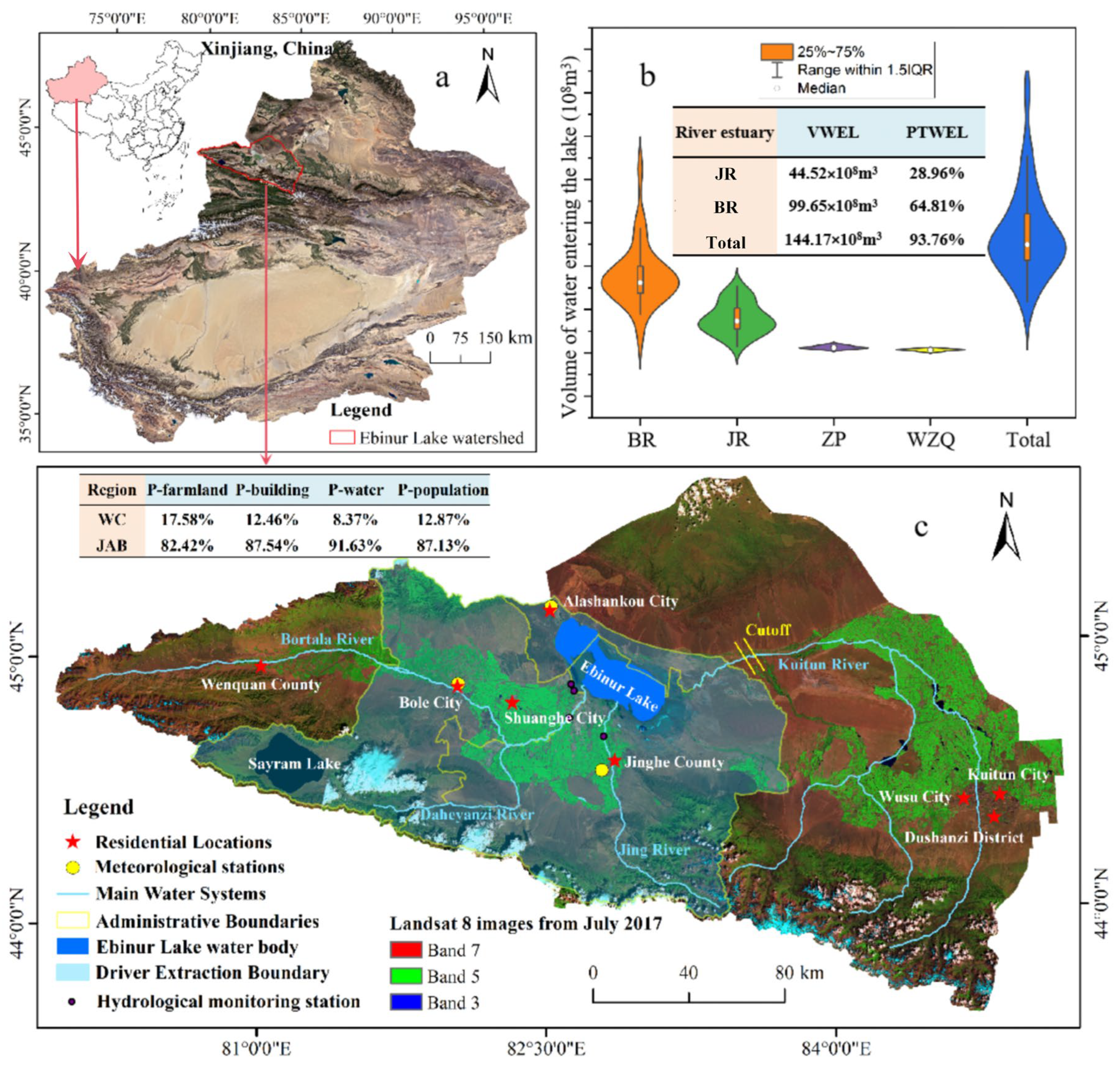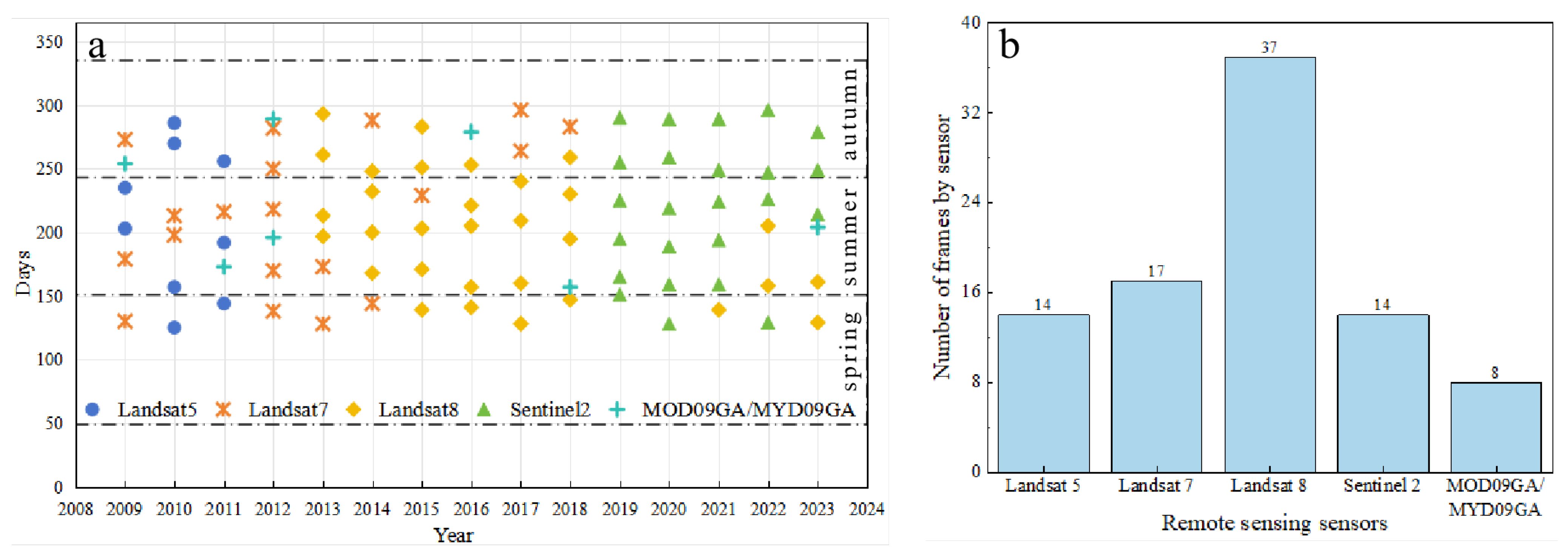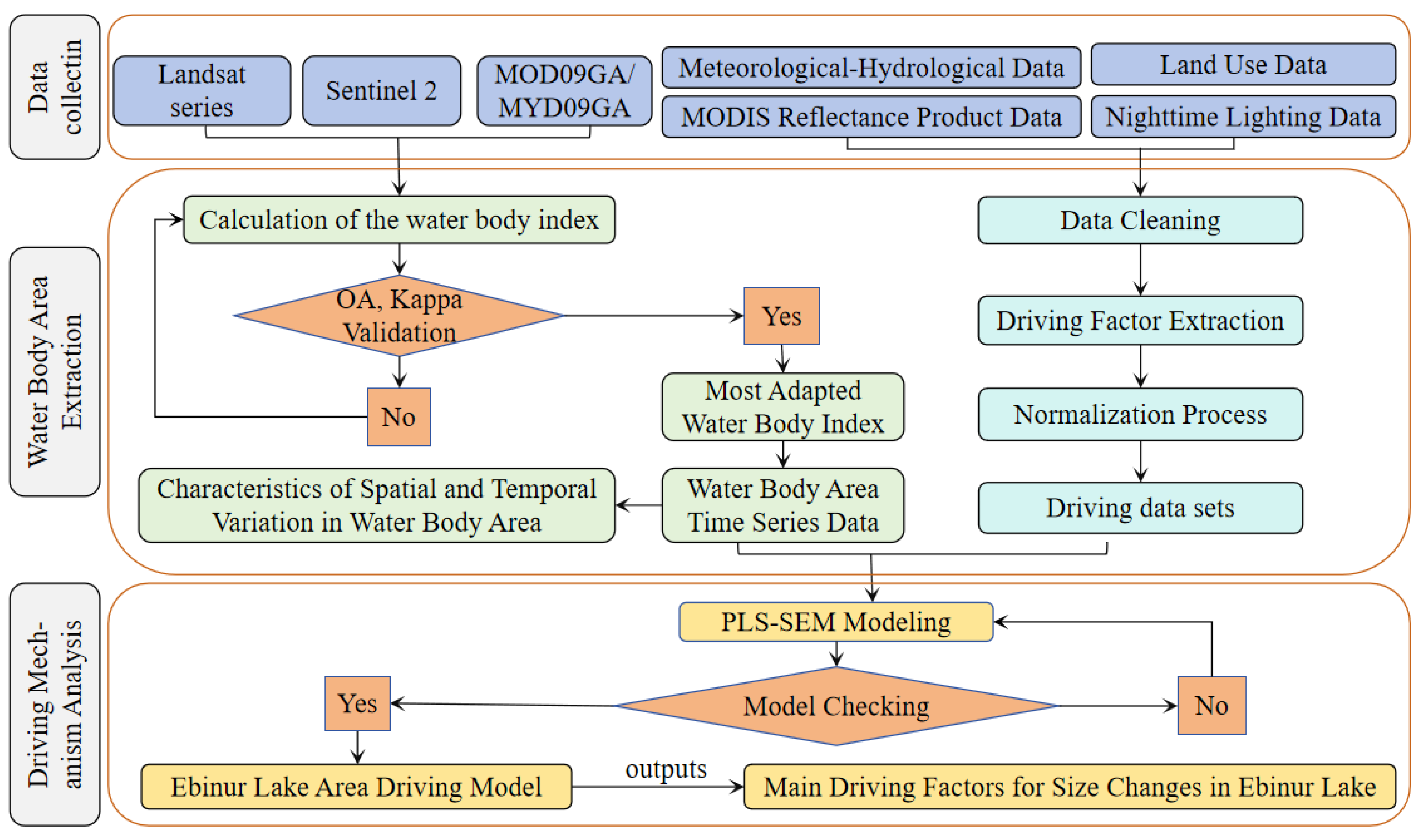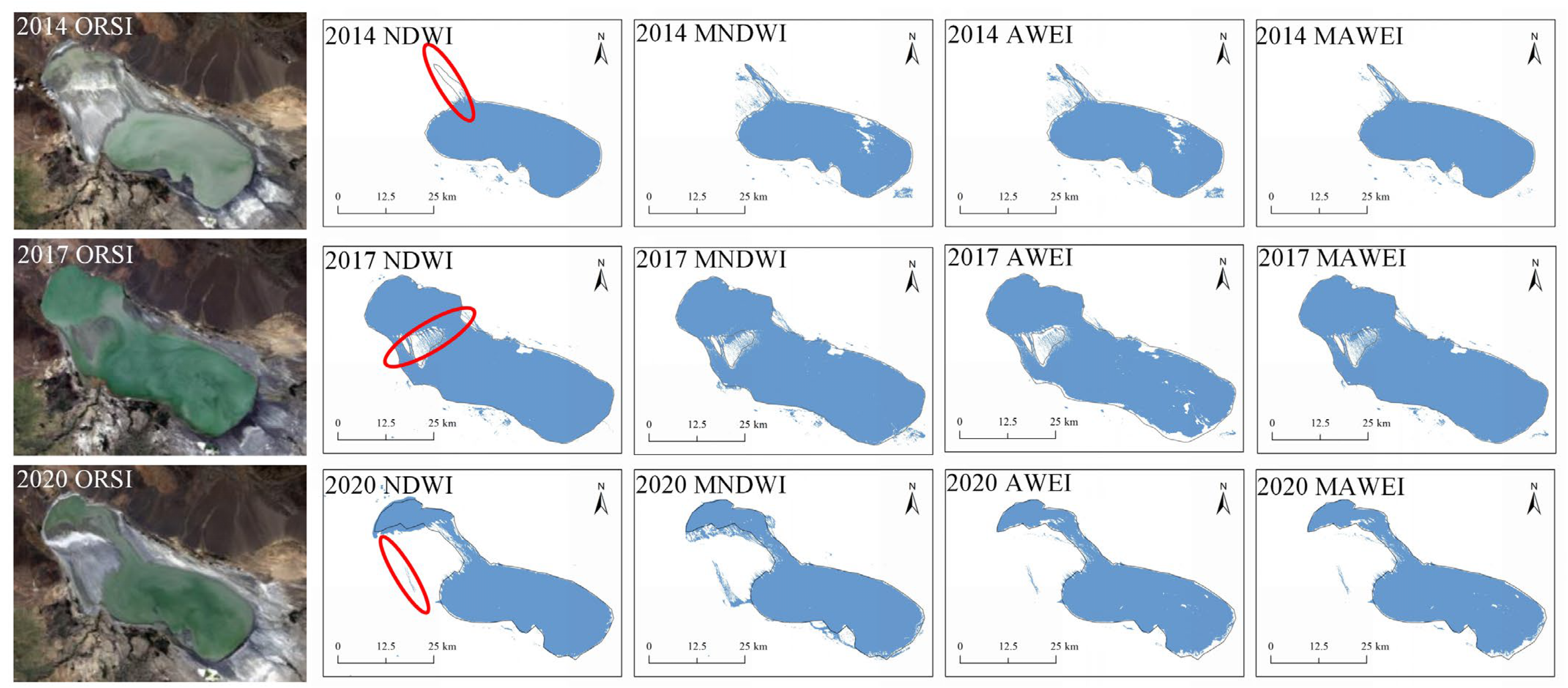Exploring the Causes of Severe Fluctuations in Water Surface Area Using Water Index and Structural Equation Modeling: Evidence from Ebinur Lake, China
Abstract
1. Introduction
2. Materials and Methods
2.1. Study Area
2.2. Data Introduction and Preprocessing
2.2.1. Remotely Sensed Data Acquisition and Preprocessing
2.2.2. Driving Data Acquisition and Processing
2.3. Method
2.3.1. Water Extraction Methods
- (1)
- Water Body Index
- (2)
- Determination of thresholds
- (3)
- Optimization of boundaries
- (4)
- Verification of accuracy
2.3.2. Method for Analysis of Changes in Lake Area
- (1)
- Chronological changes
- (2)
- Spatial Variations
2.3.3. Methodology for the Study of Mechanisms Driving Changes in Lake Area
2.3.4. Analytical Work Flow
3. Results and Analysis
3.1. Analysis of Temporal and Spatial Changes
3.1.1. Determination of the Index of Adapted Water Bodies
3.1.2. Characteristics of Temporal Changes in Water Body Area
3.1.3. Characterization of Spatial Variability in Lake Water Bodies
3.2. Analysis of the Drivers of Change in Water Body Size in Ebinur Lake
4. Discussion
4.1. Water Body Extraction Threshold Determination and Resolution Inconsistency Issues
4.2. Analysis of the Controlling Factors for Changes in the Size of Ebinur Lake
4.3. Uncertainty Analysis and Outlook
5. Conclusions
- (1)
- The water body extraction method used in this study, which combines MAWEI with the Otsu method and the Canny algorithm, can effectively identify the water area of Ebinur Lake.
- (2)
- The water area of Ebinur Lake has undergone drastic changes and generally shows a downward trend. In 2017, the area of Ebinur Lake reached its maximum value. The centroid of the lake area fluctuates back and forth from the southeast corner to the northwest corner. The area changes mainly occur in the small lake area and the transition zone.
- (3)
- Hydrological factors are the dominant factors in the area changes of Ebinur Lake, with a relative contribution rate of 64.3%. Among them, lake inflow has the greatest impact (0.812).
Author Contributions
Funding
Data Availability Statement
Acknowledgments
Conflicts of Interest
References
- Mechal, A.; Fekadu, D.; Abadi, B. Multivariate and water quality index approaches for spatial water quality assessment in Lake Ziway, Ethiopian Rift. Water Air Soil Pollut. 2024, 235, 78. [Google Scholar] [CrossRef]
- Zhang, Z.; Chen, X.; Xu, C.Y.; Hong, Y.; Hardy, J.; Sun, Z. Examining the influence of river–lake interaction on the drought and water resources in the Poyang Lake basin. J. Hydrol. 2015, 522, 510–521. [Google Scholar] [CrossRef]
- Ho, J.C.; Michalak, A.M.; Pahlevan, N. Widespread global increase in intense lake phytoplankton blooms since the 1980s. Nature 2019, 574, 667–670. [Google Scholar] [CrossRef]
- Huang, L.; Liu, J.; Shao, Q.; Liu, R. Changing inland lakes responding to climate warming in Northeastern Tibetan Plateau. Clim. Change 2011, 109, 479–502. [Google Scholar] [CrossRef]
- Qi, Z.; Cui, C.; Jiang, Y.; Chen, Y.; Ju, J.; Guo, N. Changes in the spatial and temporal characteristics of China’s arid region in the background of ENSO. Sci. Rep. 2022, 12, 17826. [Google Scholar] [CrossRef]
- Li, Q.; Lu, L.; Wang, C.; Li, Y.; Sui, Y.; Guo, H. MODIS-derived spatiotemporal changes of major lake surface areas in arid Xinjiang, China, 2000–2014. Water 2015, 7, 5731–5751. [Google Scholar] [CrossRef]
- Yao, F.; Livneh, B.; Rajagopalan, B.; Wang, J.; Crétaux, J.-F.; Wada, Y.; Berge-Nguyen, M. Satellites reveal widespread decline in global lake water storage. Science 2023, 380, 743–749. [Google Scholar] [CrossRef]
- Hao, S.; Li, F.; Li, Y.; Gu, C.; Zhang, Q.; Qiao, Y.; Jiao, L.; Zhu, N. Stable isotope evidence for identifying the recharge mechanisms of precipitation, surface water, and groundwater in the Ebinur Lake basin. Sci. Total Environ. 2019, 657, 1041–1050. [Google Scholar] [CrossRef]
- Wei, Q.; Halike, A.; Yao, K.; Chen, L.; Balati, M. Construction and optimization of ecological security pattern in Ebinur Lake Basin based on MSPA-MCR models. Ecol. Indic. 2022, 138, 108857. [Google Scholar] [CrossRef]
- Zhang, F.; Tiyip, T.; Johnson, V.C.; Kung, H.; Ding, J.; Zhou, M.; Fan, Y.; Kelimu, A.; Nurmuhammat, I. Evaluation of land desertification from 1990 to 2010 and its causes in Ebinur Lake region, Xinjiang China. Environ. Earth Sci. 2015, 73, 5731–5745. [Google Scholar] [CrossRef]
- Wang, H.; Qi, Y.; Lian, X.; Zhang, J.; Yang, R.; Zhang, M. Effects of climate change and land use/cover change on the volume of the Qinghai Lake in China. J. Arid. Land 2022, 14, 245–261. [Google Scholar] [CrossRef]
- Zhang, S.; Pavelsky, T.M. Remote sensing of lake ice phenology across a range of lakes sizes, ME, USA. Remote Sens. 2019, 11, 1718. [Google Scholar] [CrossRef]
- Zhang, F.; Tiyip, T.; Johnson, V.C.; Kung, H.-T.; Ding, J.-L.; Sun, Q.; Zhou, M.; Kelimu, A.; Nurmuhammat, I.; Chan, N.W. The influence of natural and human factors in the shrinking of the Ebinur Lake, Xinjiang, China, during the 1972–2013 period. Environ. Monit. Assess. 2015, 187, 4128. [Google Scholar] [CrossRef] [PubMed]
- Bao, A.; Mu, G.; Zhang, Y.; Feng, X.; Chang, C.; Yin, X. Estimation of the rational water area for controlling wind erosion in the dried-up basin of the Ebinur Lake and its effect detection. Chin. Sci. Bull. 2006, 51, 68–74. [Google Scholar] [CrossRef]
- Lemenkova, P. Monitoring seasonal fluctuations in saline lakes of Tunisia using Earth observation data processed by GRASS GIS. Land 2023, 12, 1995. [Google Scholar] [CrossRef]
- Li, K.; Wang, J.; Yao, J. Effectiveness of machine learning methods for water segmentation with ROI as the label: A case study of the Tuul River in Mongolia. Int. J. Appl. Earth Obs. Geoinf. 2021, 103, 102497. [Google Scholar] [CrossRef]
- Acharya, T.D.; Subedi, A.; Lee, D.H. Evaluation of water indices for surface water extraction in a Landsat 8 scene of Nepal. Sensors 2018, 18, 2580. [Google Scholar] [CrossRef]
- Wang, Z.; Liu, J.; Li, J.; Zhang, D.D. Multi-spectral water index (MuWI): A native 10-m multi-spectral water index for accurate water mapping on Sentinel-2. Remote Sens. 2018, 10, 1643. [Google Scholar] [CrossRef]
- Goffi, A.; Stroppiana, D.; Brivio, P.A.; Bordogna, G.; Boschetti, M. Towards an automated approach to map flooded areas from Sentinel-2 MSI data and soft integration of water spectral features. Int. J. Appl. Earth Obs. Geoinf. 2020, 84, 101951. [Google Scholar] [CrossRef]
- Ouma, Y.O.; Tateishi, R. A water index for rapid mapping of shoreline changes of five East African Rift Valley lakes: An empirical analysis using Landsat TM and ETM+ data. Int. J. Remote Sens. 2006, 27, 3153–3181. [Google Scholar] [CrossRef]
- McFeeters, S.K. The use of the Normalized Difference Water Index (NDWI) in the delineation of open water features. Int. J. Remote Sens. 1996, 17, 1425–1432. [Google Scholar] [CrossRef]
- Xu, H. A study on information extraction of water body with the modified normalized difference water index (MNDWI). J. Remote Sens. Beijing 2005, 9, 595. (In Chinese) [Google Scholar] [CrossRef]
- Feyisa, G.L.; Meilby, H.; Fensholt, R.; Proud, S.R. Automated Water Extraction Index: A new technique for surface water mapping using Landsat imagery. Remote Sens. Environ. 2014, 140, 23–35. [Google Scholar] [CrossRef]
- Wang, H.; Wang, J.; Cui, Y.; Yan, S. Consistency of Suspended Particulate Matter Concentration in Turbid Water Retrieved from Sentinel-2 MSI and Landsat-8 OLI Sensors. Sensors 2021, 21, 1662. [Google Scholar] [CrossRef]
- Zhou, Y.; Zhang, L.; Wang, Y. Monitoring of water extent and variation of the Poyang lake using GF-1 remote sensing data. In Proceedings of the 2017 7th International Conference on Manufacturing Science and Engineering (ICMSE 2017), Zhuhai, China, 11–12 March 2017; pp. 384–387. [Google Scholar] [CrossRef]
- Moknatian, M.; Piasecki, M.; Gonzalez, J. Development of geospatial and temporal characteristics for Hispaniola’s Lake Azuei and Enriquillo using Landsat imagery. Remote Sens. 2017, 9, 510. [Google Scholar] [CrossRef]
- Chen, K.; Liu, X.; Chen, X.; Guo, Y.; Dong, Y. Spatial characteristics and driving forces of the morphological evolution of East Lake, Wuhan. J. Geogr. Sci. 2020, 30, 583–600. [Google Scholar] [CrossRef]
- Khazaei, B.; Khatami, S.; Alemohammad, S.H.; Rashidi, L.; Wu, C.; Madani, K.; Kalantari, Z.; Destouni, G.; Aghakouchak, A. Climatic or regionally induced by humans? Tracing hydro-climatic and land-use changes to better understand the Lake Urmia tragedy. J. Hydrol. 2019, 569, 203–217. [Google Scholar] [CrossRef]
- Tao, S.; Fang, J.; Ma, S.; Cai, Q.; Xiong, X.; Tian, D.; Zhao, X.; Fang, L.; Zhang, H.; Zhu, J.; et al. Changes in China’s lakes: Climate and human impacts. Natl. Sci. Rev. 2020, 7, 132–140. [Google Scholar] [CrossRef]
- Zheng, L.; Xia, Z.; Xu, J.; Chen, Y.; Yang, H.; Li, D. Exploring annual lake dynamics in Xinjiang (China): Spatiotemporal features and driving climate factors from 2000 to 2019. Clim. Change 2021, 166, 36. [Google Scholar] [CrossRef]
- Liu, H.; Chen, Y.; Ye, Z.; Li, Y.; Zhang, Q. Recent lake area changes in Central Asia. Sci. Rep. 2019, 9, 16277. [Google Scholar] [CrossRef]
- Ding, X.; Zhang, H.; Wang, Z.; Shang, G.; Huang, Y.; Li, H. Analysis of the Evolution Pattern and Driving Mechanism of Lakes in the Northern Ningxia Yellow Diversion Irrigation Area. Water 2022, 14, 3658. [Google Scholar] [CrossRef]
- Mo, H. Comprehensive evaluation of flood and flood in the Yellow River Basin based on gray correlation analysis. J. Geosci. Environ. Prot. 2021, 9, 13. [Google Scholar] [CrossRef]
- Wieland, M.; Martinis, S.; Kiefl, R.; Gstaiger, V. Semantic segmentation of water bodies in very high-resolution satellite and aerial images. Remote Sens. Environ. 2023, 287, 113452. [Google Scholar] [CrossRef]
- Jöreskog, K.G. A general method for estimating a linear structural equation system. ETS Res. Bull. Ser. 1970, 1970, I-41. [Google Scholar] [CrossRef]
- Kim, W.; Moon, J.E.; Park, Y.J.; Ishizaka, J. Evaluation of chlorophyll retrievals from Geostationary Ocean color imager (GOCI) for the north-east Asian region. Remote Sens. Environ. 2016, 184, 482–495. [Google Scholar] [CrossRef]
- Gao, S.; Lü, Y.; Jiang, X. Increased precipitation and vegetation cover synergistically enhanced the availability and effectiveness of water resources in a dryland region. J. Hydrol. 2025, 654, 132812. [Google Scholar] [CrossRef]
- Liu, C.; Chen, Y.; Huang, W.; Fang, G.; Li, Z.; Zhu, C.; Liu, Y. Climate warming positively affects hydrological connectivity of typical inland river in arid Central Asia. npj Clim. Atmos. Sci. 2024, 7, 250. [Google Scholar] [CrossRef]
- Du, B.; Wang, Z.; Mao, D.; Li, H.; Xiang, H. Tracking lake and reservoir changes in the Nenjiang watershed, Northeast China: Patterns, trends, and drivers. Water 2020, 12, 1108. [Google Scholar] [CrossRef]
- Ma, M.; Wang, X.; Veroustraete, F.; Dong, L. Change in area of Ebinur Lake during the 1998–2005 period. Int. J. Remote Sens. 2007, 28, 5523–5533. [Google Scholar] [CrossRef]
- Wang, Y.; Gu, X.; Yang, G.; Liao, N. Impacts of climate change and human activities on water resources in the Ebinur Lake Basin, Northwest China. J. Arid. Land 2021, 13, 581–598. [Google Scholar] [CrossRef]
- Liu, C.; Zhang, F.; Tan, M.L.; Jim, C.-Y.; Song, K.; Shi, J.; Lin, X.; Kung, H.-T. High spatiotemporal resolution reconstruction of suspended particulate matter concentration in arid brackish lake, China. J. Clean. Prod. 2023, 414, 137673. [Google Scholar] [CrossRef]
- Wang, J.; Ding, J.; Li, G.; Liang, J.; Yu, D.; Aishan, T.; Zhang, F.; Yang, J.; Abulimiti, A.; Liu, J. Dynamic detection of water surface area of Ebinur Lake using multi-source satellite data (Landsat and Sentinel-1A) and its responses to changing environment. Catena 2019, 177, 189–201. [Google Scholar] [CrossRef]
- Liu, C.; Zhang, F.; Jim, C.Y.; Johnson, V.C.; Tan, M.L.; Shi, J.; Lin, X. Controlled and driving mechanism of the SPM variation of shallow Brackish Lakes in arid regions. Sci. Total Environ. 2023, 878, 163127. [Google Scholar] [CrossRef] [PubMed]
- Akbas, A. Human or climate? Differentiating the anthropogenic and climatic drivers of lake storage changes on spatial perspective via remote sensing data. Sci. Total Environ. 2024, 912, 168982. [Google Scholar] [CrossRef]
- Chen, J.; Chen, S.; Fu, R.; Li, D.; Jiang, H.; Wang, C.; Peng, Y.; Jia, K.; Hicks, B.J. Remote sensing big data for water environment monitoring: Current status, challenges, and future prospects. Earth’s Future 2022, 10, e2021EF002289. [Google Scholar] [CrossRef]
- Foroumandi, E.; Nourani, V.; Kantoush, S.A. Investigating the main reasons for the tragedy of large saline lakes: Drought, climate change, or anthropogenic activities? A call to action. J. Arid. Environ. 2022, 196, 104652. [Google Scholar] [CrossRef]
- Elvidge, C.D.; Zhizhin, M.; Ghosh, T.; Hsu, F.-C.; Taneja, J. Annual time series of global VIIRS nighttime lights derived from monthly averages: 2012 to 2019. Remote Sens. 2021, 13, 922. [Google Scholar] [CrossRef]
- Elvidge, C.D.; Baugh, K.E.; Kihn, E.A.; Kroehl, H.W.; Davis, E.R. Mapping city lights with nighttime data from the DMSP Operational Linescan System. Photogramm. Eng. Remote Sens. 1997, 63, 727–734. [Google Scholar] [CrossRef]
- Kalaiselvi, T.; Nagaraja, P.; Indhu, V. A comparative study on thresholding techniques for gray image binarization. Int. J. Adv. Res. Comput. Sci. 2017, 8, 1168–1172. [Google Scholar] [CrossRef]
- Otsu, N. A threshold selection method from gray-level histograms. Automatica 1975, 11, 23–27. [Google Scholar] [CrossRef]
- Canny, J. A computational approach to edge detection. IEEE Trans. Pattern Anal. Mach. Intell. 1986, 6, 679–698. [Google Scholar] [CrossRef]
- Yang, N.; Li, J.; Mo, W.; Luo, W.; Wu, D.; Gao, W.; Sun, C. Water depth retrieval models of East Dongting Lake, China, using GF-1 multi-spectral remote sensing images. Glob. Ecol. Conserv. 2020, 22, e01004. [Google Scholar] [CrossRef]
- de Anda, J.; Díaz-Torres, J.D.J.; Gradilla-Hernández, M.S.; de la Torre-Castro, L.M. Morphometric and water quality features of Lake Cajititlán, Mexico. Environ. Monit. Assess. 2019, 191, 92. [Google Scholar] [CrossRef]
- Liu, Q.; Huang, C.; Shi, Z.; Zhang, S. Probabilistic river water mapping from Landsat-8 using the support vector machine method. Remote Sens. 2020, 12, 1374. [Google Scholar] [CrossRef]
- Morshed, S.R.; Fattah, M.A. Responses of spatiotemporal vegetative land cover to meteorological changes in Bangladesh. Remote Sens. Appl. Soc. Environ. 2021, 24, 100658. [Google Scholar] [CrossRef]
- Jiang, N.; Li, P.; Feng, Z. Remote sensing of swidden agriculture in the tropics: A review. Int. J. Appl. Earth Obs. Geoinf. 2022, 112, 102876. [Google Scholar] [CrossRef]
- Yu, Z.; Yang, K.; Luo, Y.; Shang, C.; Zhu, Y. Lake surface water temperature prediction and changing characteristics analysis-A case study of 11 natural lakes in Yunnan-Guizhou Plateau. J. Clean. Prod. 2020, 276, 122689. [Google Scholar] [CrossRef]
- Busker, T.; de Roo, A.; Gelati, E.; Schwatke, C.; Adamovic, M.; Bisselink, B.; Pekel, J.-F.; Cottam, A. A global lake and reservoir volume analysis using a surface water dataset and satellite altimetry. Hydrol. Earth Syst. Sci. 2019, 23, 669–690. [Google Scholar] [CrossRef]
- Wang, J.; Yang, S.; Lou, H.; Liu, H.; Wang, P.; Li, C.; Zhang, F. Impact of lake water level decline on river evolution in Ebinur Lake Basin (an ungauged terminal lake basin). Int. J. Appl. Earth Obs. Geoinf. 2021, 104, 102546. [Google Scholar] [CrossRef]
- Quan, Q.; Liang, W.; Yan, D.; Lei, J. Influences of joint action of natural and social factors on atmospheric process of hydrological cycle in Inner Mongolia, China. Urban Clim. 2022, 41, 101043. [Google Scholar] [CrossRef]
- Huang, T.; Yu, D.; Cao, Q.; Qiao, J. Impacts of meteorological factors and land use pattern on hydrological elements in a semi-arid basin. Sci. Total Environ. 2019, 690, 932–943. [Google Scholar] [CrossRef] [PubMed]
- Li, J.; Yu, Y.; Wang, X.; Zhou, Z. System dynamic relationship between service water and food: Case study at Jinghe River Basin. J. Clean. Prod. 2022, 330, 129794. [Google Scholar] [CrossRef]
- Sun, W.C.; Wang, X.C.; Xu, Z.X. Research Progress and Prospect of Remote Sensing Estimation of River Discharge. Acta Geogr. Sin. 2024, 79, 565–583. (In Chinese) [Google Scholar] [CrossRef]












| Image Type | Parameters | Blue | Green | Red | NIR | SWIR1 | SWIR2 |
|---|---|---|---|---|---|---|---|
| Landsat 5 | Center wavelength (nm) | 485 | 560 | 560 | 830 | 1650 | 2215 |
| Wavelength range (nm) | 450–520 | 520–600 | 630–690 | 760–900 | 1550–1750 | 2080–2350 | |
| Resolution (m) | 30 | 30 | 30 | 30 | 30 | 30 | |
| Number of bands | SR_B1 | SR_B2 | SR_B3 | SR_B4 | SR_B5 | SR_B7 | |
| Landsat 7 | Center wavelength (nm) | 485 | 560 | 560 | 830 | 1650 | 2215 |
| Wavelength range (nm) | 450–520 | 520–600 | 630–690 | 760–900 | 1550–1750 | 2080–2350 | |
| Resolution (m) | 30 | 30 | 30 | 30 | 30 | 30 | |
| Number of bands | SR_B1 | SR_B2 | SR_B3 | SR_B4 | SR_B5 | SR_B7 | |
| Landsat 8 | Center wavelength (nm) | 483 | 561 | 655 | 865 | 1610 | 2200 |
| Wavelength range (nm) | 450–515 | 525–600 | 630–680 | 845–885 | 1560–1660 | 2100–2300 | |
| Resolution (m) | 30 | 30 | 30 | 30 | 30 | 30 | |
| Number of bands | SR_B2 | SR_B3 | SR_B4 | SR_B5 | SR_B6 | SR_B7 | |
| Sentinel 2 | Center wavelength (nm) | 490 | 560 | 665 | 842 | 1610 | 2190 |
| Wavelength range (nm) | 458–523 | 543–578 | 650–680 | 789–895 | 1565–1655 | 2105–2279 | |
| Resolution (m) | 10 | 10 | 10 | 10 | 20 | 20 | |
| Number of bands | B2 | B3 | B4 | B8 | B11 | B12 | |
| MOD09GA/MYD09GA | Center wavelength (nm) | 469 | 555 | 645 | 858 | 1640 | 2130 |
| Wavelength range (nm) | 459–479 | 545–565 | 620–670 | 841–876 | 1628–1652 | 2105–2155 | |
| Resolution (m) | 500 | 500 | 500 | 500 | 500 | 500 | |
| Number of bands | B3 | B4 | B1 | B2 | B6 | B7 |
| Category | Data Type | T | S | Data Description | Source |
|---|---|---|---|---|---|
| Hydrological factors (HFs) | Total water inflow to the lake (ZRHL) | Month | Site | River flow into Ebinur Lake | https://doi.org/10.1016/j.scitotenv.2023.163127 (accessed on 4 April 2024) |
| Water level (SW) | Day | Site | Ebinur Lake water level | ||
| Lake surface temperature (HBWD) | 8 days | 1000 m | MOD11A2 | https://earthdata.nasa.gov/ (accessed on 4 April 2024) | |
| Meteorological factors (MFs) | Average wind speed at Alashankou (AFS) | Day | Site | Wind | http://data.cma.cn/ (accessed on 4 April 2024) |
| Average wind speed at Jinghe (JFS) | Day | Site | Wind | ||
| Temperatures (QW) | Month | 1000 m | Near-surface average air temperature dataset | http://www.geodata.cn/ (accessed on 4 April 2024) | |
| Precipitation (JS) | Month | 1000 m | Monthly precipitation dataset | ||
| Evapotranspiration (ET) | 8 days | 500 m | MOD16A2 | https://earthdata.nasa.gov/ (accessed on 5 April 2024) | |
| Aerosols (AOD_047) | Day | 1000 m | MCD19A2 | ||
| Soil–vegetation systems (S-Vs) | Cropland NDVI (GNDVI) | 16 days | 500 m | MOD13A1 | https://earthdata.nasa.gov/ (accessed on 4 April 2024) |
| Forest–grassland NDVI (LNDWI) | 16 days | 500 m | MOD13A1 | ||
| Normalized Difference Salinity Index (TNDSI) | Day | 250 m | Calculated by MOD09GQ | ||
| Human activities (HAs) | Cultivated land (GDMJ) | Year | 30 m | Land use data | https://doi.org/10.5281/zenodo.4417810 (accessed on 4 April 2024) |
| Construction land (JSMJ) | Year | 30 m | Land use data | ||
| Nighttime light (YJDG) | Month | 500 m | OLS/VIIRS | https://eogdata.mines.edu/ (accessed on 4 April 2024) | |
| Lake size changes (HPMJ) | Ebinur Lake area | Month | 30 m/10 m | Time-series data on the area of Ebinur Lake | Water extraction results |
| Latent Variable | R2 | Q2 |
|---|---|---|
| Soil–vegetation systems | 0.589 | 0.441 |
| Hydrological factors | 0.674 | 0.248 |
| Lake area changes | 0.745 | 0.717 |
Disclaimer/Publisher’s Note: The statements, opinions and data contained in all publications are solely those of the individual author(s) and contributor(s) and not of MDPI and/or the editor(s). MDPI and/or the editor(s) disclaim responsibility for any injury to people or property resulting from any ideas, methods, instructions or products referred to in the content. |
© 2025 by the authors. Licensee MDPI, Basel, Switzerland. This article is an open access article distributed under the terms and conditions of the Creative Commons Attribution (CC BY) license (https://creativecommons.org/licenses/by/4.0/).
Share and Cite
Li, M.; Liu, C.; Zhang, F.; Chan, N.W.; Adam, E.; Wang, W.; Wu, Y. Exploring the Causes of Severe Fluctuations in Water Surface Area Using Water Index and Structural Equation Modeling: Evidence from Ebinur Lake, China. Remote Sens. 2025, 17, 1431. https://doi.org/10.3390/rs17081431
Li M, Liu C, Zhang F, Chan NW, Adam E, Wang W, Wu Y. Exploring the Causes of Severe Fluctuations in Water Surface Area Using Water Index and Structural Equation Modeling: Evidence from Ebinur Lake, China. Remote Sensing. 2025; 17(8):1431. https://doi.org/10.3390/rs17081431
Chicago/Turabian StyleLi, Mengfan, Changjiang Liu, Fei Zhang, Ngai Weng Chan, Elhadi Adam, Weiwei Wang, and Yingxiu Wu. 2025. "Exploring the Causes of Severe Fluctuations in Water Surface Area Using Water Index and Structural Equation Modeling: Evidence from Ebinur Lake, China" Remote Sensing 17, no. 8: 1431. https://doi.org/10.3390/rs17081431
APA StyleLi, M., Liu, C., Zhang, F., Chan, N. W., Adam, E., Wang, W., & Wu, Y. (2025). Exploring the Causes of Severe Fluctuations in Water Surface Area Using Water Index and Structural Equation Modeling: Evidence from Ebinur Lake, China. Remote Sensing, 17(8), 1431. https://doi.org/10.3390/rs17081431








